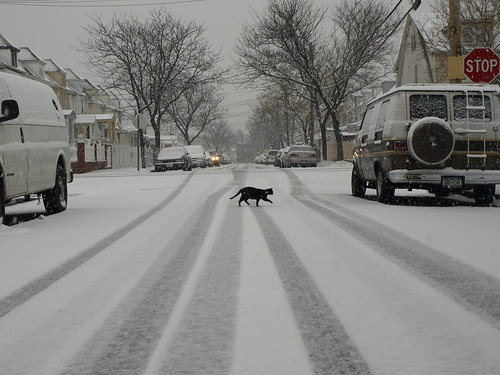Brrr! I’m not too sure about the rest of you, but it’s getting pretty frosty here in NYC as the holiday season is rolling around. One thing that you see while walking around is people fiddling with their cameras trying to shoot in the cold weather. Perhaps they’re wearing gloves, or their glasses are frosted up, or they’re hands are shivering amongst other things. To help you and those other folks out, here are a couple of tips to keep in mind how to shoot in the cold with a point-and-shoot and a DSLR.
1. Wear Gloves with Cut Away Fingers
Chances are that you’re wearing gloves and that pressing the little buttons on your point-and-shoot has become tedious. I pity you if you’ve got a touchscreen camera in this situation. Something I’ve seen aspiring photographers do is wear gloves with the upper parts of the fingers cut away. Most of their hands are now staying warm and they’ve made the compromise for taking better photos and operating their cameras with better ease of use.
For the most part, a DSLR can be operated with gloves on as the buttons are generally big enough. My 5D Mk II has no problems with my gloves. When I shot the above photo, I was wearing thick gloves while shooting my Olympus E-510. The thick gloves didn’t help much so I found myself getting rid of them while shooting.
2. Put the Camera Down on a Flat, Stable Surface
Eric has a posting on more principles of photography marksmanship, but I’ve always recommended ditching a tripod and using your environment when you need one. Your camera has a self-timer, everyone does. Try using it to take the photo you want. This way you can set up your shot perfectly. If you’re out and want to take a picture of you and a loved one (and don’t have a Samsung TL225 or TL 220) then you will probably want to do this instead.
3. Hold The Camera With Two Hands
If you say that you’re not cold and that you get stable shots while hand-holding with one hand: congratulations. However, it is generally a well known fact that if you hold your camera with two hands, your auto-focus will have a better chance at hitting the intended target due to the extra stability. This becomes even more critical in low light at night. Facial recognition usually works well enough, but not all cameras do this well at night. To aid it, hold it with two hands. You’re also less likely to drop it this way too.
4. Protect Your Camera From Condensation
I’ve seen condensation get on the lens of cameras because people are going in and out of warm and cold places. Your lens is important, and getting moisture in there will mess with the electronics and motors. Try to keep your camera one temperature. As a starting tip, try keeping it under your jacket. Most entry-level DSLRs are small enough to do this. Otherwise, if you’re a female your purse will do well.
5. To Get Closer to Real Life Results, Raise the ISO
While strolling around Bryant Park the other night and upon realizing that the S90, G11 and entry-level DSLRs are eating up the consumer market share, my eyes felt like they stepped into the equivalent of a room being flashbanged by the NYPD. The reason for this is because everyone is using their flash. Whether it’s an Olympus E-620 or a Sony A230, people are using them just the way they would a standard point-and-shoot.
To be more subtle, raise the ISO. Your results will be closer to what it looks like in real life without the washed out colors. Unless you truly know how to use a flash, try to avoid it. Most pros will recommend that you never use on-camera flash. I’m one of them.
What tips can you add to shooting in cold weather?



One more very importance tiP
Not all camera and/or there battery can work in the cold,
so make sure it can work in the cold.
If you got a camera can’t take the cold, keep them inside you winter coat to keep it warm before you need to use them
Regarding the condensation issue…living here in SW Ohio I was warned to be very careful about taking out my Canon dSLR into the cold from a warm and toasty house or car (and vice versa). It was strongly recommended to me to place my camera in a plastic bag, tie it off, and then place it into the conditions where I will be shooting for an hour or so in advance of using it.
This allows the camera, lens(es), etc. drop or rise in temperature slowly and carefully and prevent condensation from forming. All the electronics in modern cameras and lenses do not like or need moisture in them.
Granted, this method is of no use if you need to snap a picture NOW of something outside, but if you can plan ahead I fully support this method.
I recently did a portrait session outside in the snow, a few things I would add;
1) on my left hand I wore a mitt (you know the ones with no fingers) and the right hand I wore a semi thin glove, so that I could change camera setting easily. When I wasn’t shooting I put the gloved hand in my jacket pocket which had a hand warmer inside.
2) Keep at lest one extra battery in your pocket as close to your skin as possible to keep it warm, so that you can switch it when the one in your camera freezes.
3) With snow on the ground, it acts as a huge reflector, use this to your advantage!
4) Have fun!
Heres a few from the shoot: http://drgphotography.ca/2009/12/calgary-photographer-brett-julia-sneak-peak/
@Drew – Great tips! That’s a good point about snow on the ground. Thanks for chiming in.
Dress extra warm, long underwear, two knit hats, multiple layers. If you are going to be standing still taking pictures you will not generate as much internal heat as when constantly walking, so if you want to be comfortable and not feel freezing cold, dress extra warm.
I agree, keep extra batteries warm, in a shirt pock or a sweatshirt pocket under your jacket where they will stay warm. Fingerless gloves on my button pressing hand (regular gloves/mittens on the other), I also take big easy on/off mittens to go over the fingerless when not shooting. Put the camera inside your jacket if you have room for it there.
Take sun glasses if you are out all day. Bright reflected light off the snow can cause eye strain and eventually temporary snow blindness if you are out all day.
keep extra batteries in a warm pocket close to your body. Electronics eat up batery power much more quickly in cold weather. Good idea to keep a set of hand warmers available to warm up you hands after shooting in the cold.
Working as a ski instructor in the Austrian Alps and carring a camera with me all the times, I will say:
1. The extra battery kept as close to your body is very important.
2. If your taking photos of snow and the sun is shining watch out for the right color balance, auto color balance will do in many cases, but you might have to correct it later, as the snow usually get a blue color cast.
3. Set the exposure compensation to a negative number when taking photos in a snow covered landscape with the sun out.